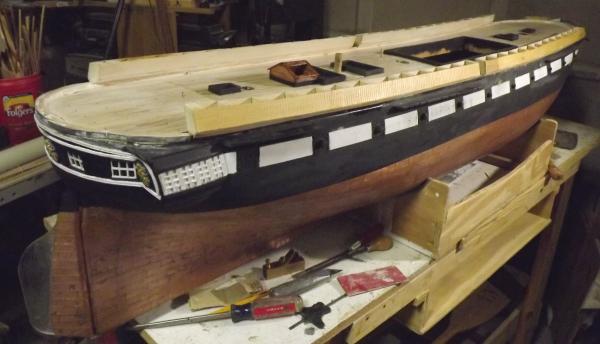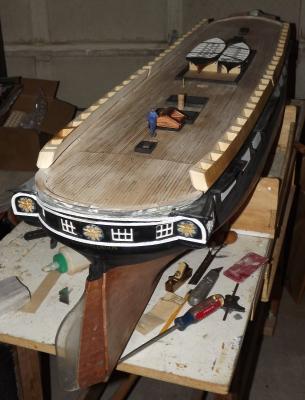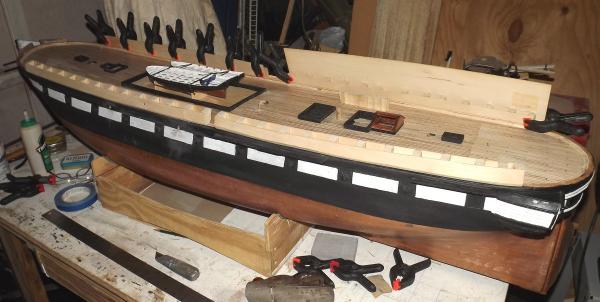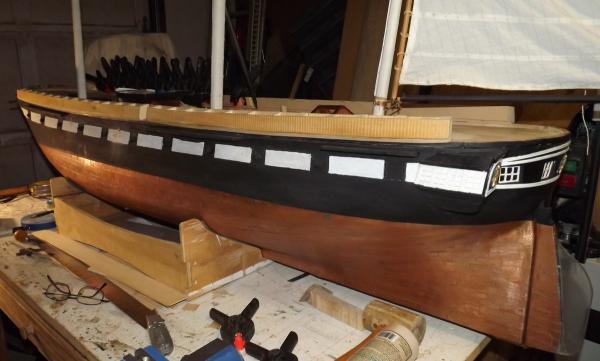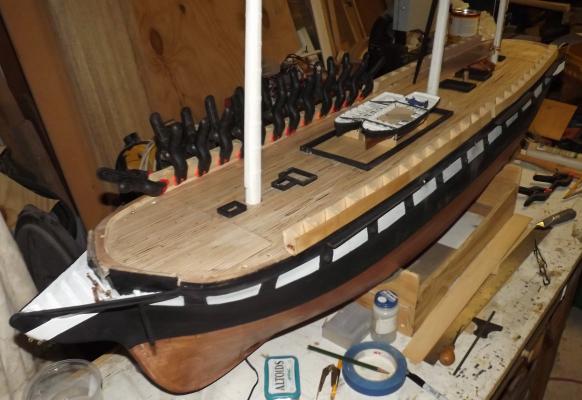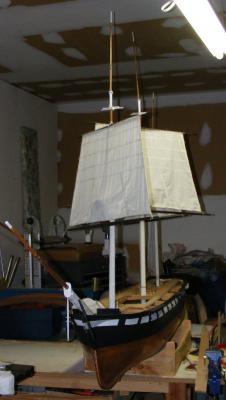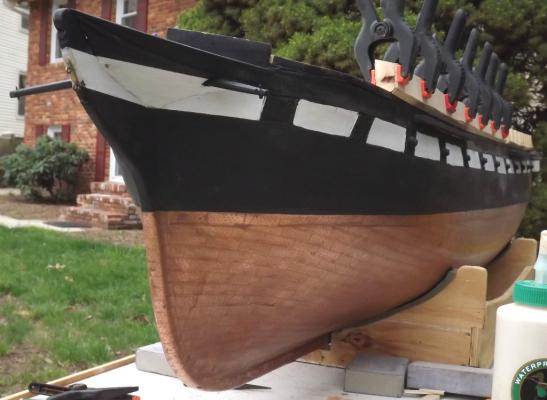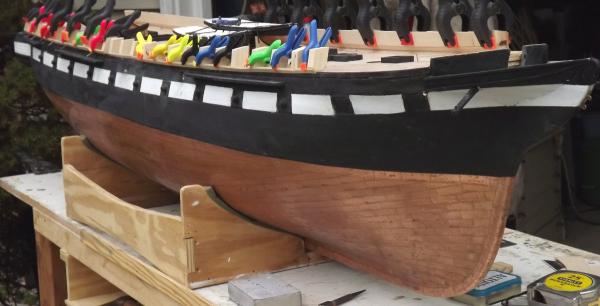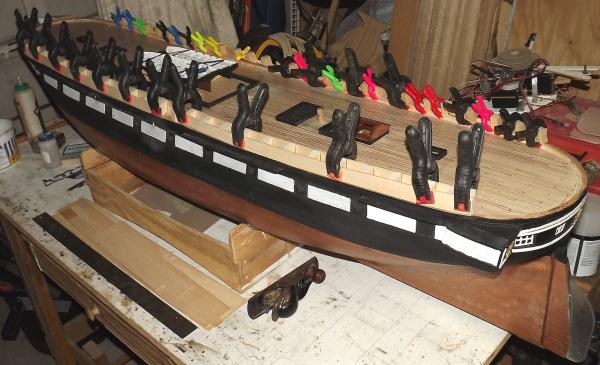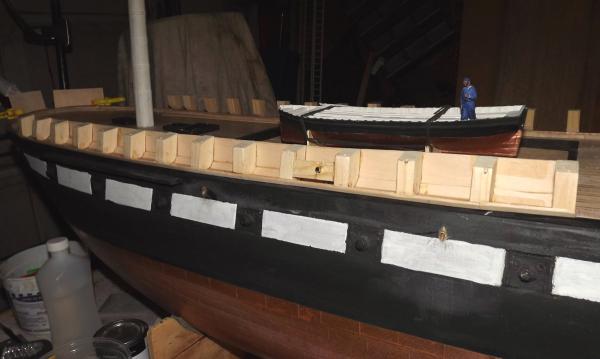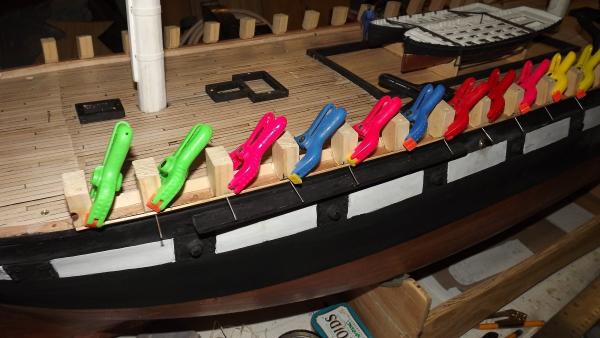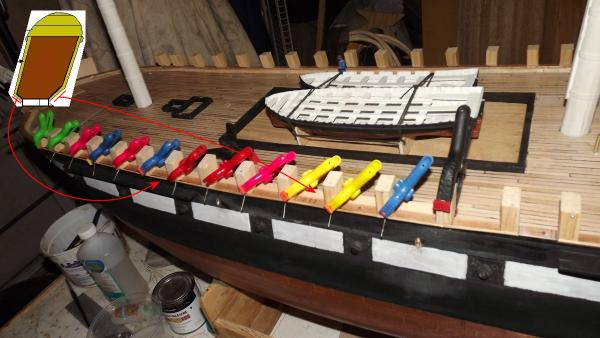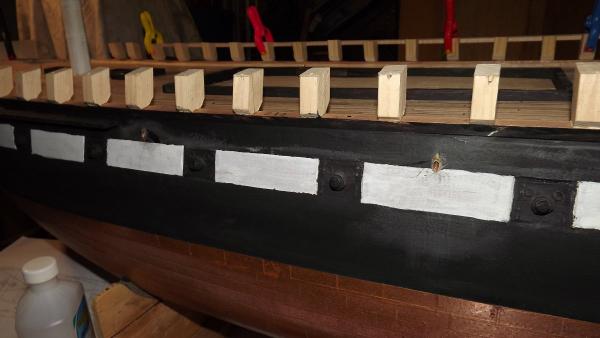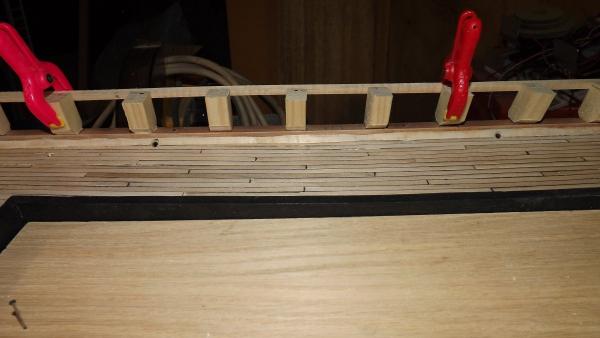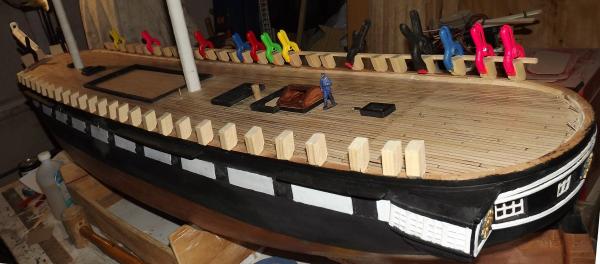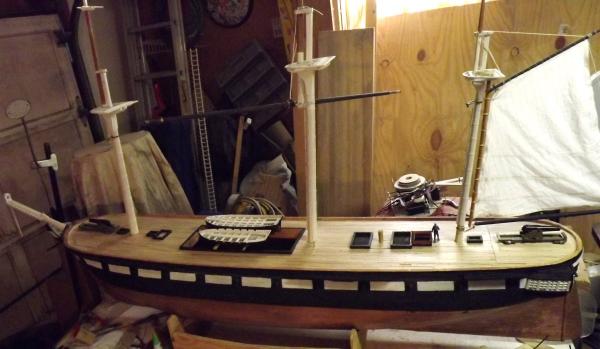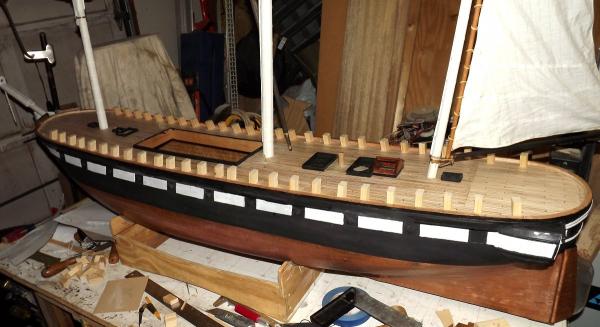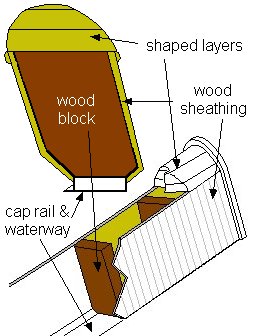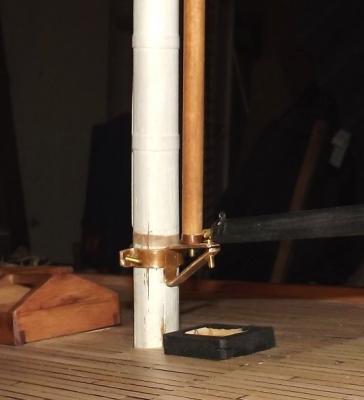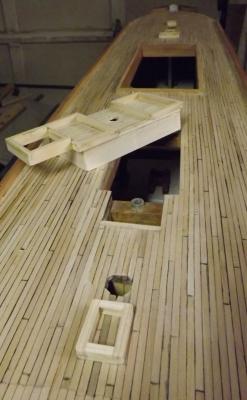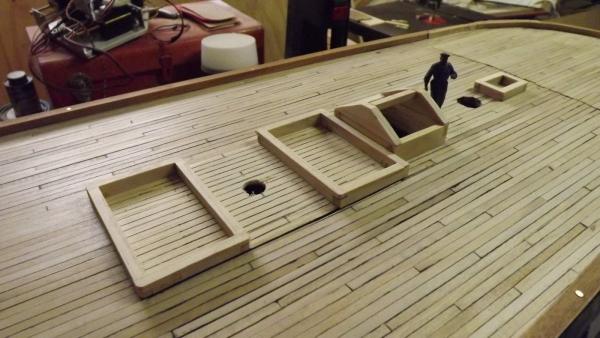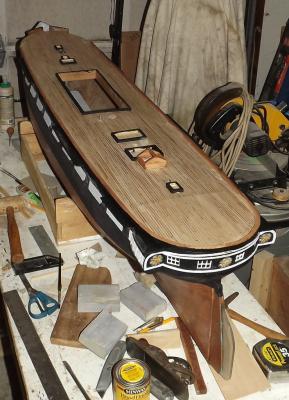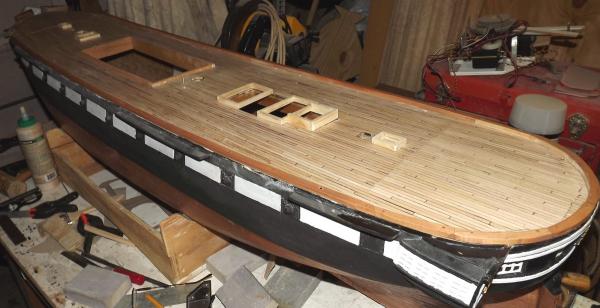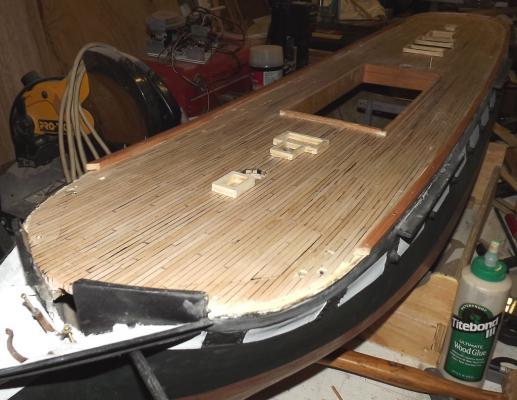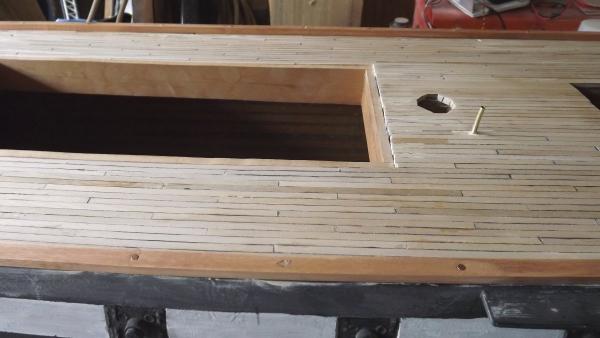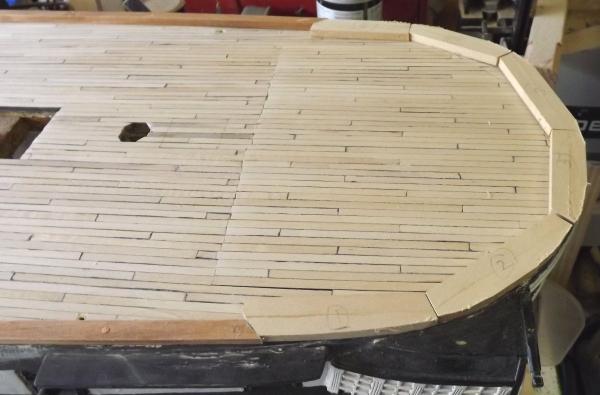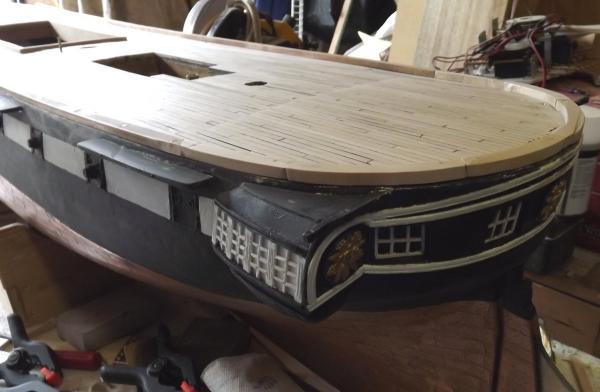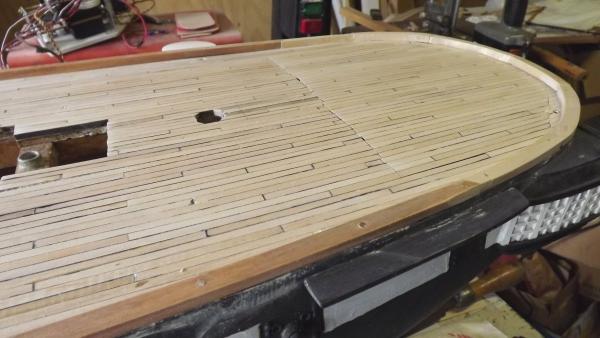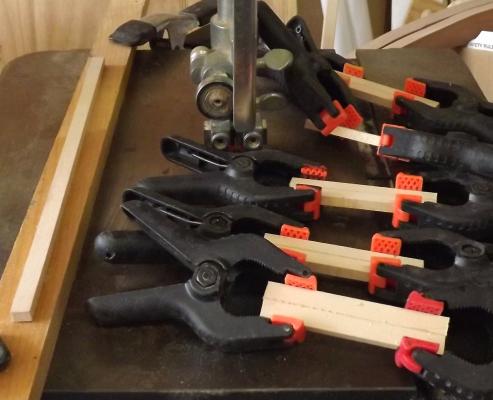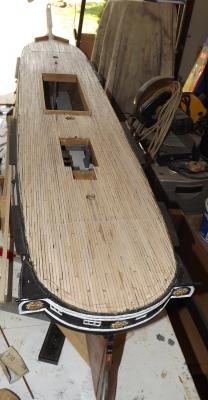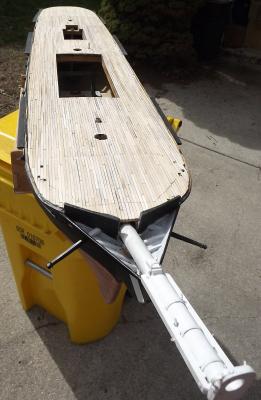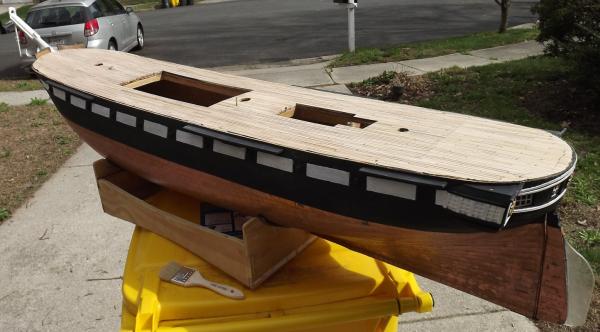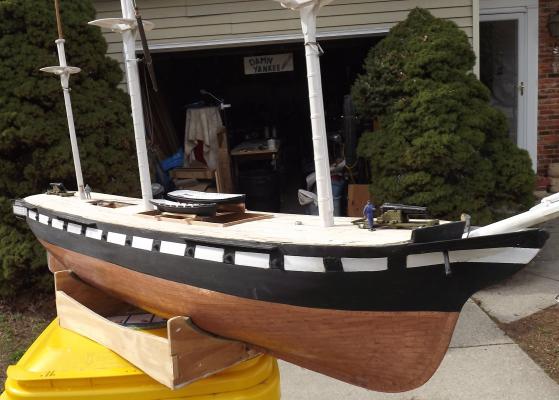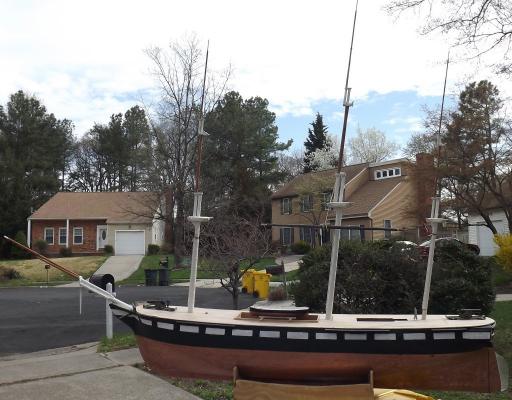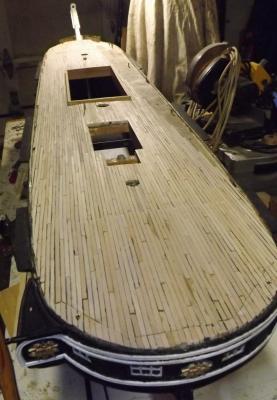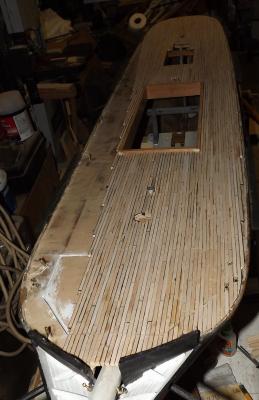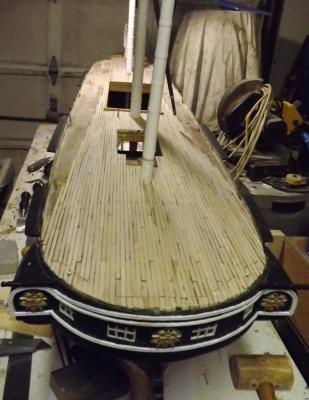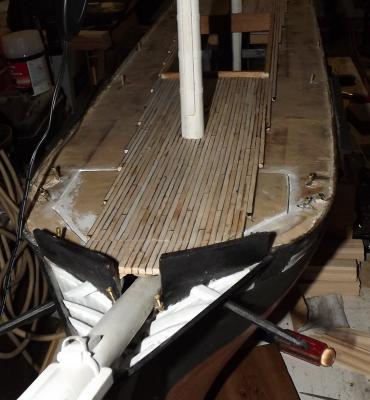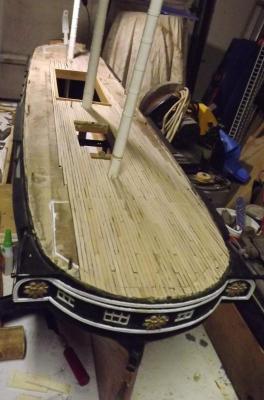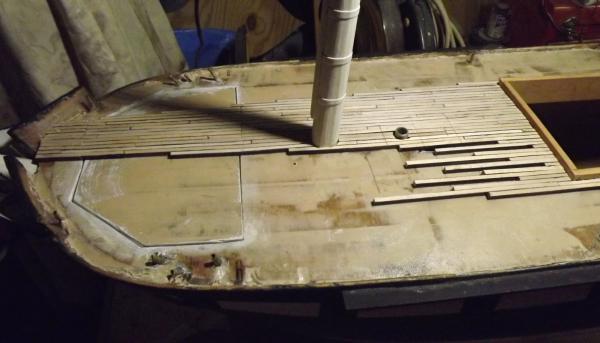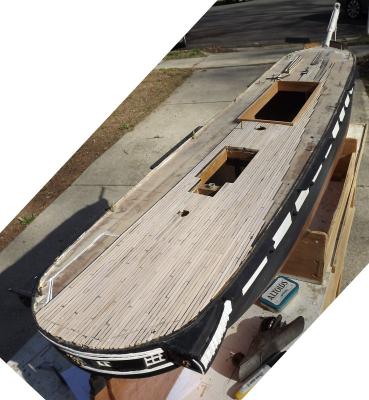-
Posts
875 -
Joined
-
Last visited
Content Type
Profiles
Forums
Gallery
Events
Everything posted by JerryTodd
-
Break time! All the hammock rails are installed, puttied, sanded, scribed, and even given a coat of paint.
- 553 replies
-
- sloop of war
- constellation
-
(and 3 more)
Tagged with:
-
Still three weeks to water time Bob. I hope to get some very provocative poses then, and some video too. Today though, I plugged along on the hammock rails. I'm going ahead with closing up inboard and outboard sides, instead of leaving them open to paint inside. The uncut panels are clamped in place and marked inside. Then they're cut, trimmed, beveled, and glued in place. I put a coat of poly on the outside to harden the wood a little and scribed the vertical staving on. The port side is all together, trimmed, and scribed. There's some little gaps to close up, then I'll actually poly rather than paint the insides. Here the starboard outboard panel just got glued on.
- 553 replies
-
- sloop of war
- constellation
-
(and 3 more)
Tagged with:
-
I've heard Lenthall took some pointers from the merchant ship builders who had been building world class ships for a decade by 1854. When Stad Amsterdam was in town I could almost see them side-by-side and see some of that clipper ship influence in Constellation. A couple more sexy poses for ye
- 553 replies
-
- sloop of war
- constellation
-
(and 3 more)
Tagged with:
-
Continued on the hammock rails. Would have gotten more done, but I only have so many clamps that will work. All the lower panels are in, the inboard upper panels on the port side, and the outboard port side ones are fitted, ready to install.
- 553 replies
-
- sloop of war
- constellation
-
(and 3 more)
Tagged with:
-
Kit-bashed is better said to use a kit as a base, using other kits parts, not kits parts etc..to make a model other than that the kit was meant to be. For instance, I could bash the Revell Arizona kit into the Arizona as she appeared in the photos when the pres was aboard; as she appeared when built with cage masts, etc; as she appeared on 12/7/41, even as she appears now, at the bottom of Pearl Harbor. All those kit-bashings are still making the kit's original subject, Arizona, but different versions that that kit does not allow for out-of-the-box.
-
Took off the clamps this morning. The tube is the guide that routes the fores'l sheet below. All this will get painted inside before I put on the outboard panel.
- 553 replies
-
- sloop of war
- constellation
-
(and 3 more)
Tagged with:
-
I don't think I'll have grating figured out in time for her next sail at the N.S. Savannah on May 17th, so I made a temporary hatch cover for the main hatch yesterday, and today made choke to hold the boats. This is just so she'll look a little better on display. I began installing the covering boards on the hammock rails, starting with the lower ones first, inboard and outboard. Once these are set, I'll install the next panel up inboard. I need to put some blocking and brass tubing in where the through blocks for the fore and main sheets come through the bulwark. I'll also paint the insides before putting the outboard cover on. They look a bit like feed troughs with stalls for farm animals at the moment.
- 553 replies
-
- sloop of war
- constellation
-
(and 3 more)
Tagged with:
-
- 553 replies
-
- sloop of war
- constellation
-
(and 3 more)
Tagged with:
-
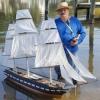
3D printing tests (Form1+)
JerryTodd replied to iMack's topic in CAD and 3D Modelling/Drafting Plans with Software
Ye know while you're melting all that plastic you could be making a Macedonian figurehead in 1:36 scale. -
The cap rail at the bow was installed: And I started making the blocks that will make the bulwarks. Here they're just sitting on the deck near where they'll be installed, and a sketch of how they work:
- 553 replies
-
- sloop of war
- constellation
-
(and 3 more)
Tagged with:
-
- 553 replies
-
- sloop of war
- constellation
-
(and 3 more)
Tagged with:
-
Ah spring time. The air is full of fumes from glue, paint, and mineral spirits.... not to mention the neighbor's lovely smelling fertilizer. Today I continued on the hatch coamings; trimming, fitting, and building the battery hatch cover. Everything, and the hull got some paint to spiff things up a bit. I really need to figure out making hatch gratings with what I have.
- 553 replies
-
- sloop of war
- constellation
-
(and 3 more)
Tagged with:
-
- 553 replies
-
- sloop of war
- constellation
-
(and 3 more)
Tagged with:
-
I installed the cap rail, or cap log as I call it. It covers the perimeter of the whole deck. An angled piece will go inside of it as the waterway, but we're not that far along yet. Here a fellow's setting a hammock iron on the real cap rail. I got 4 3/8" x 1/4" x 48" bass strips and two of them were simply spring into place port and starboard. Tren'led every 6" with round toothpicks, and since I couldn't clamp it down very well, I put in copper nails between each tren'l. I wiped a little cherry stain on the strips before fastening them down. I cut one of the remaining 2 strips into 3-1/2" lengths and glued them up side-by-side to make 6 1/4" x 3/4" x 3-1/2" blocks A made a card stock template of the stern and used that to shape the blocks and piece together the cap rail around the stern.
- 553 replies
-
- sloop of war
- constellation
-
(and 3 more)
Tagged with:
-
- 553 replies
-
- sloop of war
- constellation
-
(and 3 more)
Tagged with:
-
I'm not too concerned with it falling a hundred feet and shattering. To me it's sailing a boat with a really long invisible tiller.
- 553 replies
-
- sloop of war
- constellation
-
(and 3 more)
Tagged with:
-
Got the port side planked up except for some "corners" to fill in. Didn't get to finish the whole deck - such are the best laid plans of mice and men. But then, there's tomorrow.
- 553 replies
-
- sloop of war
- constellation
-
(and 3 more)
Tagged with:
-
I got a bit more done. The forward access hatch is nearly covered and that will finish all those fiddly bits dealing with it's seams. The aft hatch is done and there's decking from stem to stern, now it's filling in the bow quarters. If the glue and the wood hold out, I should have it done tomorrow.
- 553 replies
-
- sloop of war
- constellation
-
(and 3 more)
Tagged with:
-
I ain't touching that till there's a sealant of some sort on the deck
- 553 replies
-
- sloop of war
- constellation
-
(and 3 more)
Tagged with:
-
There will be a bit of gasket material in there - there's some card stuck there now to take up the space while I fit the decking. I'm not going for "water-tight" more like "water-resistant." Today I hope to get the aft end planked and work up the port side. I'm thinking it'll all be down by Wednesday. There's a cap that goes all around the edge of the deck, it's more like a log. I have to piece that together around the bow and stern, the sides are simply a nice long piece that springs on. I got a bag of bamboo skewers I'm going to use as tren'ls to anchor that down. While she won't be "finished" at that point, she'll look more like she is. I need to turn the spokes for the wheel and those bowling pin stanchions, but none of the wood I have handy is working out for that. I had a little boxwood which I think will do great, but I haven't been able to find it.
- 553 replies
-
- sloop of war
- constellation
-
(and 3 more)
Tagged with:
-
Got TWO bottles of gel CA and continued with a few more strakes up the port side, and got down a lot of the foredeck area.
- 553 replies
-
- sloop of war
- constellation
-
(and 3 more)
Tagged with:
-

Using a sheave on a double block as a becket???
JerryTodd replied to Captain Al's topic in Masting, rigging and sails
I have seen a stopper knot at the sheave, and the line rove through the 2 doubles then to a belaying pin. In this case the original becket block failed (the phenolic sheave split) and they only had a double block handy. (this was on a real vessel, not a model). To me, a line made off to a eye-bolt implies that the belay at the other end is the working end and that second sheave is used but the line is made-off at the block. -
- 553 replies
-
- sloop of war
- constellation
-
(and 3 more)
Tagged with:
-
Sometime during the Cretaceous period (2009 to be precise), when I designed and installed the deck beams, I got it into my head to make it all this thick. The plywood was what I had on hand, so that's easy, but I can't for the life of me recall why I opted to make the deck planking this thick. Not just the deck, but the deck beams as well, there's no need for them to be as large as I've made them. Pride is done the same way, but set up to use 1/16" (1mm?) planking. In her case the planking, while thinner, is about twice as wide, and using CA to glue it down may be an issue. Macedonian is going to use 1/8" luan plywood (door-skin) for a sub-deck and 1/16" thick planking over that. A 4' x 8' sheet of door-skin sells for about the same as a 1' x 2' sheet of 1/16" aircraft ply, so I'll get thicker decks, but I get fo'c's'le, quarter deck, and gundeck with a good bit of ply left over for a whole lot cheaper.
- 553 replies
-
- sloop of war
- constellation
-
(and 3 more)
Tagged with:
About us
Modelshipworld - Advancing Ship Modeling through Research
SSL Secured
Your security is important for us so this Website is SSL-Secured
NRG Mailing Address
Nautical Research Guild
237 South Lincoln Street
Westmont IL, 60559-1917
Model Ship World ® and the MSW logo are Registered Trademarks, and belong to the Nautical Research Guild (United States Patent and Trademark Office: No. 6,929,264 & No. 6,929,274, registered Dec. 20, 2022)
Helpful Links
About the NRG
If you enjoy building ship models that are historically accurate as well as beautiful, then The Nautical Research Guild (NRG) is just right for you.
The Guild is a non-profit educational organization whose mission is to “Advance Ship Modeling Through Research”. We provide support to our members in their efforts to raise the quality of their model ships.
The Nautical Research Guild has published our world-renowned quarterly magazine, The Nautical Research Journal, since 1955. The pages of the Journal are full of articles by accomplished ship modelers who show you how they create those exquisite details on their models, and by maritime historians who show you the correct details to build. The Journal is available in both print and digital editions. Go to the NRG web site (www.thenrg.org) to download a complimentary digital copy of the Journal. The NRG also publishes plan sets, books and compilations of back issues of the Journal and the former Ships in Scale and Model Ship Builder magazines.


